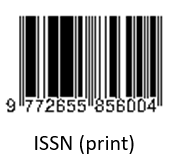Comparative Study of Master Oil (MO) and Lophira Lanceolata (Ochnaceae) Oil (LLO) Lubricants in Sewing Machines
(1) Department of Physics, Modibbo Adama University, P M B 2076 Yola, Nigeria.
(2) Department of Physics, Modibbo Adama University
(3) Department of Industrial Mathematics, Modibbo Adama University
(4) Department of Basic Science, Federal Polytechnic Damaturu
(*) Corresponding Author
Abstract
In this paper, the Flash point, Fire point, Cloud point, Pour point, and Volatility of master oil (MO) and locally processed lophira lanceolata oil (LLO) were determined using standard laboratory methods. The results show that LLO has lower volatility which means it can stay longer in moving parts of a machine than MO. Also, the results show that the flash point and fire point of the lubricants lie within the maximum operating temperature range (<300 oC) of sewing machines. The high pour point (14 oC) and cloud point (23 oC) of LLO limit its use as a lubricant in low temperate regions of the world as opposed to -14 oC and -7 oC respectively for MO which has universal application. This implies LLO needs to be chemically blended with some additive agents that can lower its Pour point so that it can favourably compete with other lubricants used in sewing machines worldwide.
Full Text:
PDFReferences
J.B. Yerima, J.S Madugu,P. Timtere, and Y.M David. “Dependence of viscosity and density of Nigerian lophira lanceolata oil (ochnaceae) on temperature”. Physical Review and Research International.2(3):125-132. 2012.
B.F Adeosun, F.O Adu, K.O Ipinmoroti, “Thermodynamics of viscous flow of some Nigerian vegetable oils”. NJET, 14(2), 165-170. 1997.
R. Ghogomu, and B.L Sondengam. “Two new cleaved bioflavonoids from Lophira lanceolata”. J. Nat. Prod. 52(2),284-288. 1989.
H.M Burkill, “A Review of Daziel’s the useful Plants of West Africa”. Royal Botanical
Garden Kew .1(3),12-34. 1985
I.C Eromosele, “Studies on the Chemical composition and Physicochemical properties of Seeds of some Wild plants”, Plant Foods for Human Nutrition. 46, 361-365. 1994.
F. Samuel, and I.K Maimuna, “Biomass potentials of lophira lanceolata fruit as a renewable energy source”, Africa journal of biotechnology, 7(3),308-310. 2008.
G. Nonviho, C. Paris, and L. Muniglia, “Chemical characterization of Lophira lanceolata and Carapa procera seed oils: Analysis of Fatty Acids, Sterols, Tocopherols and Tocotrienols”. Research Journal of Chemical Sciences. 4(9), 57-62. 2014.
H. Yu-Lung and L. Chun-Chu. “Evaluation and Selection of Regeneration of Waste Lubricating Oil Technology”. J. Environ Monit. 2010.
W.B Dennis, "Used oil: resource or pollutant?". Technology Review, 46-52. 2010
A. Mazari, and A. Havelka. “Sewing machine needle temperature of an industrial lockstitch machine,” J. Industria Textila. 65(6), 335-339. 2014.
K. C Wanta, I.C.N Simanungkalit, E. P. Bahri, R.F Susanti, G.P Gemilar, W. Astuti, and H. T. B. M Petrus. “Study of Nickel Extraction Process from Spent Catalysts with Hydrochloric Acid Solution: Effect of Temperature and Kinetics Study”, International Journal of Applied Sciences and Smart Technologies, 3(2), 161–170. 2021
P.S. Prabowo, S. Mardikus, and E. Credo. “Heat Transfer Characteristic on Wing Pairs Vortex Generator using 3D Simulation of Computational Fluid Dynamic”, International Journal of Applied Sciences and Smart Technologies, 3(2), 215–224. 2021.
DOI: https://doi.org/10.24071/ijasst.v4i2.5165
Refbacks
- There are currently no refbacks.
Publisher : Faculty of Science and Technology
Society/Institution : Sanata Dharma University

This work is licensed under a Creative Commons Attribution 4.0 International License.











